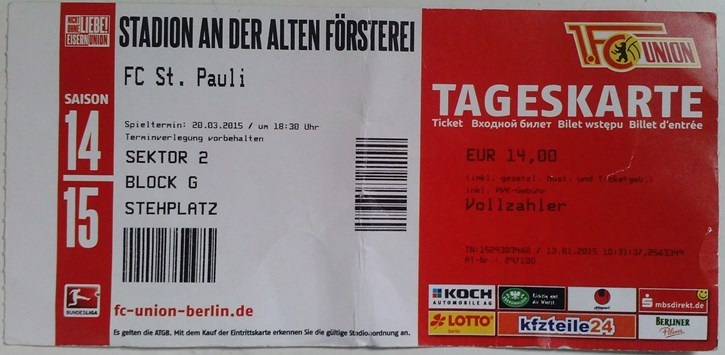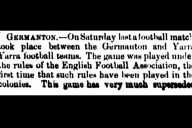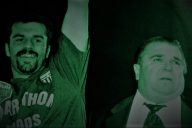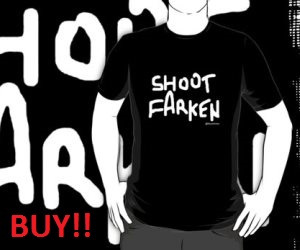1. FC Union Berlin vs. FC St.Pauli at Stadion An der Alten Försterei
FC Union: 1: St.Pauli: 0
Football is a practice of cultural production. Being a fan is intrinsic to issues of identity – nationalism, parochialism, ideology, gender. The football stadium is, most often, an overwhelmingly male space. Fans claim space within the city; filling up trains and dominating sidewalks. The traces of their activities are left on walls: posters advertising games, graffiti and murals, and of course, the ubiquitous initials, ACAB (All Cops are Bastards or, more humorously All Chiquitas are Bananas).
Going to a game involves a local migration, or a movement from outside of the city or from further afield. The big games of the Premier League, Champions League, etc, attract travellers from other continents. Packages costs thousands, probably. Fans in England adopt German clubs out of respect for the ‘German model’ and the culture of fandom present in Germany. Football is imagined as more real, more authentic and more closely a part of its community. The hallmarks of this being cheaper tickets, louder fans, and a greater involvement of the fans with the management and identity of the club.
***
I met Josh at Berlin Hauptbahnhof at 3:30pm. He was reading a book by David Sedaris and leaning up against the half-body height fibreglass wall. Blue jacket; mild winter’s day. The train had arrived on time and Josh was early. The train had already briefly stopped at the station closest to his home, Berlin-Charlottenburg, and we would be going back there to drop my stuff; one backpack full of not much. No computer, no running gear: just a couple of newspapers and a minor change of clothes. A short trip. On the way through, there was a congregation of Hertha Berlin fans at Charlottenburg. They were dressed in their blue and white beanies, scarves and civvies. I thought perhaps we could give their game a go since the tickets for the 2. Bundesliga (second division) meeting between “Kult” clubs 1.FC Union Berlin and (soon-to-be bottom placed) FC St.Pauli had proved difficult to obtain. The tickets were being sold to members only. And, not being members we had tried less-official channels of possible access. Josh had contacted Union and said that I was a journalist and would be writing on the fans. Probably not the first time they had heard such a line. And, I had tried to get in touch with the guy who runs Union in Englisch, but no cigar. Josh said that black tickets were often sold outside most games. He was confident we would have a 50% chance of getting black tickets. At what price, not too sure. And so, with a little under two hours before the early kick off time of 6:30pm, we set off from Charlottenburg and went southeast to Stadion An der Alten Försterei (Stadium at the Old Forester’s House).
The stadium’s capacity is 21,000 – much of it is standing room. It is only the West stand that is seated. The seated stand is indeed the calmest stand. The visitors, those from the Hamburg district of St.Pauli, 300km up the road, are occupying the Southern End. Perhaps it is the acoustics or the wind, but their chants aren’t heard throughout the game. A small section of their contingent wave their flags continually throughout the game, and, at the game’s conclusion, they hold their scarves out-stretched and aloft – in some kind of act of defiance; a statement of loyalty. St.Pauli appear headed for relegation to the third tier of German football, after another loss – this one no doubt a little difficult to take, given FC Union’s goal came from the goalkeeper’s blunder in the 89th minute. After the whistle was blown, Ante Budimir (No.14), stood alone in the St.Pauli half, turning slowly around and watching the Union fans celebrate joyously. He took some time before slowly walking towards the centre of the pitch where the other players were gathered for the usual shaking of hands, back slapping and quick and gentle embraces. This defeat was heavy; relegation seemingly increasingly difficult to escape.
There is only one capo (chant leader). He stands, as usual, with his back to the game, gesturing manically to the fans. He is armed with his megaphone; and other megaphones are lined up along the stand. This seems to be a missed opportunity for the placement of other capos: perhaps there were more in the past. I wonder when the system of four or so megaphones came into place. There are no capos along the standing Eastern stand. The away fans, too, haven’t unleashed their capo; this would be too much provocation, probably. A net hangs down at each end of the pitch and a couple of loose shots fly into this net. Fans stand behind an imposing fence. After Union score their goal, a fan runs onto the pitch – from where, it is unclear – and is escorted around the periphery, where the escorting security guards are shouted at. The intruder is roughed up and walked away uncomfortably. A man hangs a cream tote bag over the fence with the letters: FCK CPS written in the style of Run DMC – Adidas design.
We watch the first half from the walkway between the two sections of the stand at the Northern End. Beer sellers roam up and down, dispensing beer from a keg strapped to their backs. The keg runs out half way through the second beer and Josh is only charged for one and a half-beers. Red discarded heavy paper lies in bunches at our feet; used as part of the choreography prior to the game. We missed it; we were buying sausages and beer.
The anthem had been sung before we entered Sector 2; those Union Fans still outside had stopped in their steps, or got up on benches and sung the song, “Eisern Union” by Nina Hagen. On the inside and during the game, many of the fans sing; particularly at the rear, but, directly behind the goals, it is probably less than half. Now and then there is back and forth between the fans on the East and the North. The most unifying being the simple chant of ‘eisern’, ‘eisern’, meaning ‘iron’. Union had almost scored with their first shot of the day, almost justifying their chant of ‘one shot, one goal’. Ultras aim for 90 minutes of chanting, the Union fans were good; probably clocking in 85 minutes of chanting; there were a few brief interruptions. After St.Pauli continued playing while a Union player was injured, the negative chant of ‘scheisser Pauli’ emerges, but, up until then, it seemed only to be about Union.
After having the view blocked for the majority of the first half, we moved into the lower section of the North End. As we moved into a relatively empty space, a tallish neat and blond man said to Josh, “that’s a pretty brave move”. And then, after Josh’s inquiry, “I wouldn’t do it. Just move a metre to your left and you’ll be fine.” We had shifted our presence into someone else’s space and it wasn’t appreciated. And so Josh politely said, “we will move out of your friend’s way, no problem.” When the hitherto absent friend arrived we were asked to move another 40 centimetres eastward. The Union fans helped build the stadium with 140,000 hours of their time. The fans rejected the move to install seats, even though more money can be earned through having fully seated stadiums. The fans kept standing room as this is what makes watching the game more fun. Watching is active. If one wants to be passive, one has to work for it; to choose to be apart, but the default act of watching is being active and participatory.
***
The police presence at the nearest metro station indicated a fear that there could be trouble. And, peremptorily the police had grabbed onto one suspected trouble maker who didn’t seem the least bit ruffled. His mates came up to the confrontation without aggro, too. All part of the event, possibly. Later in a punkish bar in Kreuzberg we came across some St.Pauli fans seemingly not the least concerned by their side’s defeat.
The game provides a moment for a disparity of fans, supporters and interlopers to congregate together; to get in one’s way, to accidentally take up another’s space; to get in the way of when one is taking photos of the old school scoreboard. Football tourism for some. The assertion of authenticity for others.
Andy Fuller writes on sport and urban culture. He contributes to tigertigerburningbright.com.au and his own website is readingsideways.net


















